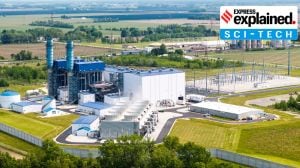NASA plane scrams to Mach 7
A revolutionary jet engine flew faster than seven times the speed of sound in a high altitude test over the Pacific on Saturday, marking wha...

A revolutionary jet engine flew faster than seven times the speed of sound in a high altitude test over the Pacific on Saturday, marking what NASA scientists hailed as a milestone in developing the ‘‘Holy Grail’’ of space travel.
NASA’s 12-foot-long (3.6 metre) X-43A research vehicle — resembling a winged surfboard — hit slightly over Mach 7, about 5,000 mph (8,000 km/H), during 11 seconds of powered flight before gliding at hypersonic speeds for several minutes and finally plunging into the ocean.
The test, conducted off the southern California coast, marked the first time that a ‘‘scramjet’’, or supersonic-combustion ramjet, has powered a vehicle at such high speed.
‘‘The ramjet-scramjet is the Holy Grail of aeronautics in my mind,’’ project manager Joel Sitz told the briefing. ‘‘If you go from ground to space, you need to use a ramjet-scramjet if you’re going to do it in the most efficient way you can.’’
Rather than carrying both the fuel and oxygen needed to provide acceleration, like a conventional rocket engine does, scramjet engines carry only hydrogen and pull the oxygen needed to burn it from the atmosphere.
Researchers at the NASA Dryden Flight Research Centre at Edwards Air Force Base hope the new engine will revolutionise aviation, speeding the development of significantly faster aircraft and lowering the cost of launching payloads.Huebner said the test had set a world speed record for a craft powered by an air-breathing engine.
‘‘To put this in perspective, a little over 100 years ago a couple of guys from Ohio flew for 120 feet (40 metres) in the first controlled powered flight,’’ he said, referring to the Wright brothers.
‘‘Today, we did something very similar in the same amount of time, but our vehicle under air-breathing power went over 15 miles.’’
Project Chief Engineer Griffin Corpening said NASA had shown what was possible. ‘‘Now business and industry and the military can come forward with confidence that they can now use this kind of a propulsion system,’’ he said.
Later this year, NASA researchers hope to test the engine at Mach 10, or about 7,000 mph (11,265 km/H), as part of their Hyper-X programme.



- 01
- 02
- 03
- 04
- 05




























